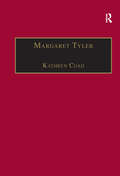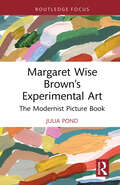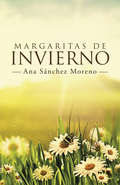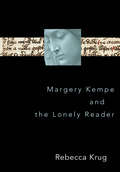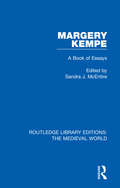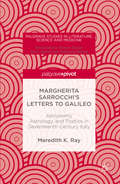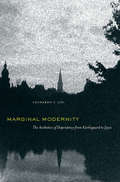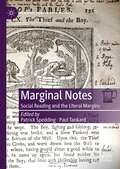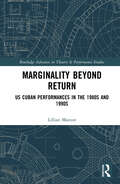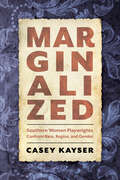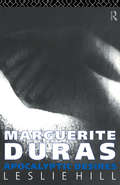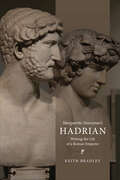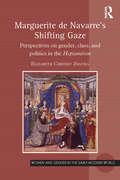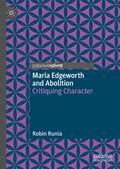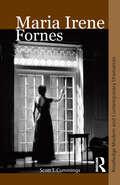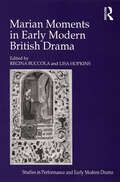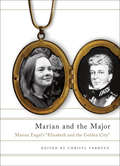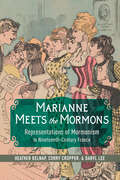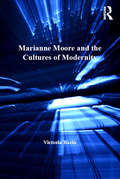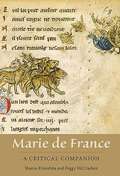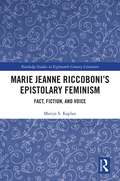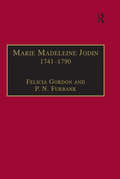- Table View
- List View
Margaret Tyler: Printed Writings 1500–1640: Series 1, Part One, Volume 8 (The Early Modern Englishwoman: A Facsimile Library of Essential Works & Printed Writings, 1500-1640: Series I, Part One #Vol. 8)
by Kathryn CoadThe biography of Margaret Tyler remains speculative. It is known that she served the Howard family (Thomas Howard, Duke of Norfolk) in some capacity. Her level of education has been described as ’amazing’ for a woman who was outside of the aristocracy and possibly a middle-class servant. Her translation (published 1579 or 1580) of Diego Ortún]ez de Calahorra’s romance, Espejo de principes y cavalleros, Part I, from the original Spanish, marks not only a notable moment in book history but also the beginning of the popularity and availability of continental romance in England. Tyler was the first woman to publish a romance in England and the first English translator to work from the original Spanish. Because of the negative association of women with romance (considered a masculine domain) and the general cultural restrictions on female authorship, Tyler’s bold defence of her translation in the dedication and preface is remarkable, and as it is the earliest Englishwoman’s defence of women’s literary work, it has sometimes earned her the title of the first English feminist.
Margaret Wise Brown’s Experimental Art: The Modernist Picture Book (Routledge Focus on Literature)
by Julia PondIn this study, the engaging art created by children’s author Margaret Wise Brown receives the critical attention it deserves as a lasting contribution to American children’s literature. Through analysis of her dozens of titles published during the height of western Modernism, this scholarly text shares Brown’s importance and impact from the perspective of Brown’s work, rather than biographically. Moving beyond such popular titles as Goodnight Moon and The Runaway Bunny into deeper cuts reveals how Brown’s oeuvre bridges multiple disciplines, including writing, visual art, philosophy, and music. Her projects successfully experiment with artistic collaboration and synesthesia as a natural expression for a child readership while both contributing to and reflecting high Modernism amidst the two World Wars. The quality of Brown’s writing and the maturity of her themes reveal respect for her child audience and recommend her work to the generations of readers who followed her early death. As this book demonstrates, Margaret Wise Brown remains one of the truly great authors of children’s literature.
Margaritas de Invierno
by Ana Sánchez MorenoUna historia ficticia, tan real como la vida misma. <P><P> Sin mirar atrás, Isabela, una mujer que sobrevivió a las calamidades que la vida le puso en su camino y que con corazón, coraje, sudor y lágrimas consiguió salir adelante de las miserias de este mundo, donde solo los privilegiados tienen oportunidades.
Margery Kempe and the Lonely Reader
by Rebecca KrugSince its rediscovery in 1934, the fifteenth-century Book of Margery Kempe has become a canonical text for students of medieval Christian mysticism and spirituality. Its author was a fifteenth-century English laywoman who, after the birth of her first child, experienced vivid religious visions and vowed to lead a deeply religious life while remaining part of the secular world. After twenty years, Kempe began to compose with the help of scribes a book of consolation, a type of devotional writing found in late medieval religious culture that taught readers how to find spiritual comfort and how to feel about one's spiritual life. In Margery Kempe and the Lonely Reader, Rebecca Krug shows how and why Kempe wrote her Book, arguing that in her engagement with written culture she discovered a desire to experience spiritual comfort and to interact with fellow believers who also sought to live lives of intense emotional engagement.An unlikely candidate for authorship in the late medieval period given her gender and lack of formal education, Kempe wrote her Book as a revisionary act. Krug shows how the Book reinterprets concepts from late medieval devotional writing (comfort, despair, shame, fear, and loneliness) in its search to create a spiritual community that reaches out to and includes Kempe, her friends, family, advisers, and potential readers. Krug offers a fresh analysis of the Book as a written work and draws attention to the importance of reading, revision, and collaboration for understanding both Kempe’s particular decision to write and the social conditions of late medieval women’s authorship.
Margery Kempe: A Book of Essays (Routledge Library Editions: The Medieval World #33)
by Sandra J. McEntireOriginally published in 1992, Margery Kempe looks at one of the most appealing mystics and pilgrims of 15th-century England. The book looks at Margery Kempe, and her book The Book of Margery Kempe, thought to be the first vernacular autobiography in medieval Britain. Original essays in the book examines Kempe's spirituality, cultural context, and the autobiography itself, The Book of Margery Kempe. The essays in the book represent detail literary analysis on Kempe and the critical history of her words.
Margherita Sarrocchi's Letters to Galileo: Astronomy, Astrology, and Poetics in Seventeenth-Century Italy (Palgrave Studies in Literature, Science and Medicine)
by Meredith K. RayThis book examines a pivotal moment in the history of science and women’s place in it. Meredith Ray offers the first in-depth study and complete English translation of the fascinating correspondence between Margherita Sarrocchi (1560-1617), a natural philosopher and author of the epic poem, Scanderbeide (1623), and famed astronomer, Galileo Galilei. Their correspondence, undertaken soon after the publication of Galileo’s Sidereus Nuncius, reveals how Sarrocchi approached Galileo for his help revising her epic poem, offering, in return, her endorsement of his recent telescopic discoveries. Situated against the vibrant and often contentious backdrop of early modern intellectual and academic culture, their letters illustrate, in miniature, that the Scientific Revolution was, in fact, the product of a long evolution with roots in the deep connections between literary and scientific exchanges.
Marginal Modernity: The Aesthetics of Dependency from Kierkegaard to Joyce
by Leonardo F. LisiTwo ways of understanding the aesthetic organization of literary works have come down to us from the late 18th century and dominate discussions of European modernism today: the aesthetics of autonomy, associated with the self-sufficient work of art, and the aesthetics of fragmentation, practiced by the avant-gardes. In this revisionary study, Leonardo Lisi argues that these models rest on assumptions about the nature of truth and existence that cannot be treated as exhaustive of modernist form.Lisi traces an alternative aesthetics of dependency that provides a different formal structure, philosophical foundation, and historical condition for modernist texts. Taking Europe's Scandinavian periphery as his point of departure, Lisi examines how Søren Kierkegaard and Henrik Ibsen imagined a response to the changing conditions of modernity different from those at the European core, one that subsequently influenced Henry James, Hugo von Hofmannsthal, Rainer Maria Rilke, and James Joyce.Combining close readings with a broader revision of the nature and genealogy of modernism, Marginal Modernity challenges what we understand by modernist aesthetics, their origins, and their implications for how we conceive of our relation to the modern world.
Marginal Notes: Social Reading and the Literal Margins (New Directions in Book History)
by Paul Tankard Patrick SpeddingMarginal Notes: Social Reading and the Literal Margins offers an account of literary marginalia based on original research from a range of unique archival sources, from mid-16th-century France to early 20th-century Tasmania. Chapters examine marginal commentary from 17th-century China, 18th-century Britain, and 19th-century America, investigating the reputations, as reflected by attentive readers, of He Zhou, Pierre Bayle, Samuel Johnson, Thomas Warton, and Sir Walter Scott. The marginal writers include Jacques Gohory, Mary Astell, Hester Thrale, Herman Melville, the young daughters of the Broome family in Gloucestershire, and the patrons of the library of the Huon Mechanics’ Institute, Tasmania. Though marginalia is often proscribed and frequently hidden or overlooked, the collection reveals the enduring power of marginalia, concluding with studies of the ethics of annotation and the resurrected life of marginalia in digital environments.
Marginal Spaces and Cultures of Dissent in Socialist Romania's Black Sea (Modernity, Memory and Identity in South-East Europe)
by Ruxandra-Iuliana CanacheThis book analyzes two Romanian villages – 2 Mai and Vama Veche – as spaces of relative freedom during the last decades of socialist rule. This microhistorical study refutes simplistic views of the communist past which focus on political figures and events, and instead explores ordinary people and everyday life. Taking a multidisciplinary approach, it considers a broad range of sources, including official Communist Party documents, secret police files, personal memoirs, oral history interviews, ethnographic films, songs, and artistic performances. This book intertwines three narrative threads: that of the visitors (mainly members of the Romanian intelligentsia, young people, and hippies); that of the local inhabitants; and that of 'authority' (local and central state agents actively engaged in surveillance and supervision). In doing so, it interrogates the spectrum of consent/dissent and resistance/collaboration hitherto neglected in scholarship.
Marginal Subjects
by Akiko TsuchiyaLate nineteenth-century Spanish fiction is populated by adulteresses, prostitutes, seduced women, and emasculated men - indicating an almost obsessive interest in gender deviance. In Marginal Subjects, Akiko Tsuchiya shows how the figure of the deviant woman--and her counterpart, the feminized man - revealed the ambivalence of literary writers towards new methods of social control in Restoration Spain.Focusing on works by major realist authors such as Benito Pérez Galdós, Emilia Pardo Bazán, and Leopoldo Alas (Clarín), as well as popular novelists like Eduardo López Bago, Marginal Subjects argues that these archetypes were used to channel collective anxieties about sexuality, class, race, and nation. Tsuchiya also draws on medical and anthropological texts and illustrated periodicals to locate literary works within larger cultural debates. Marginal Subjects is a riveting exploration of why realist and naturalist narratives were so invested in representing gender deviance in fin-de-siècle Spain.
Marginality Beyond Return: US Cuban Performances in the 1980s and 1990s (Routledge Advances in Theatre & Performance Studies)
by Lillian ManzorThis study is an exploration of US Cuban theatrical performances written and staged primarily between 1980 and 2000. Lillian Manzor analyzes early plays by Magali Alabau, Jorge Ignacio Cortiñas, María Irene Fornés, Eduardo Machado, Manuel Martín Jr., and Carmelita Tropicana as well as these playwrights’ participation in three foundational Latine theater projects --INTAR’s Hispanic Playwrights-in-Residence Laboratory in New York (1980-1991), Hispanic Playwrights Project at South Coast Repertory Theater in Costa Mesa, CA (1986-2004), and The Latino Theater Initiative at Center Theater Group's Mark Taper Forum in Los Angeles (1992-2005). She also studies theatrical projects of reconciliation among Cubans on and off the island in the early 2000s. Demonstrating the foundational nature of these artists and projects, the book argues that US Cuban theater problematizes both the exile and Cuban-American paradigms. By investigating US Cuban theater, the author theorizes via performance, ways in which we can intervene in and reformulate political and representational positionings within the context of hybrid cultural identities. This book will of great interest to students and scholars in Performance Studies, Transnational Latine Studies, Race and Gender studies.
Marginalized: Southern Women Playwrights Confront Race, Region, and Gender
by Casey KayserWinner of the 2021 Eudora Welty PrizeIn contrast to other literary genres, drama has received little attention in southern studies, and women playwrights in general receive less recognition than their male counterparts. In Marginalized: Southern Women Playwrights Confront Race, Region, and Gender, author Casey Kayser addresses these gaps by examining the work of southern women playwrights, making the argument that representations of the American South on stage are complicated by difficulties of identity, genre, and region. Through analysis of the dramatic texts, the rhetoric of reviews of productions, as well as what the playwrights themselves have said about their plays and productions, Kayser delineates these challenges and argues that playwrights draw on various conscious strategies in response. These strategies, evident in the work of such playwrights as Pearl Cleage, Sandra Deer, Lillian Hellman, Beth Henley, Marsha Norman, and Shay Youngblood, provide them with the opportunity to lead audiences to reconsider monolithic understandings of northern and southern regions and, ultimately, create new visions of the South.
Marguerite Duras: Apocalyptic Desires
by Leslie HillMarguerite Duras is France's best-known and most controversial contemporary woman writer. Duras' influence extends from her early novels of the 1950's to her radically innovative experimental autobiographical text of the 1980's The Lover Leslie Hill's book throws new light on Duras' relationship to feminism, psychoanalysis, sexuality, literature, film, politics, and the media. Feted by Kristeva, and Laca who claimed her as almost his other self, Duras is revealed to be a profoundly transgressive thinker and artist. It will be a must for all concerned with contemporary writing, writing by women, recent European cinema, film and literature.
Marguerite Yourcenar’s Hadrian: Writing the Life of a Roman Emperor (Phoenix Supplementary Volumes #62)
by Keith BradleyMarguerite Yourcenar is best known as the author of the 1951 novel Mémoires d’Hadrien, her recreation of the life of the Roman emperor Hadrian. The work can be examined from the perspective of the issues raised by writing Roman imperial biography at large and the many ways in which Mémoires has a claim to historical authenticity. In Marguerite Yourcenar’s Hadrian, Keith Bradley explains how Mémoires d’Hadrien came to be written, gives details of Yourcenar’s own biography, and describes some of the intricate historical problems that her novel’s portrait of Hadrian presents. He draws on Yourcenar’s correspondence, her interviews with journalists, and her literary corpus as a whole, emphasizing Yourcenar’s profound knowledge of the ancient evidence on which her life of Hadrian is based and exploiting a wide range of contemporary Yourcenarian criticism. The book pays special attention to the methods by which Yourcenar believed Hadrian’s life history to be recoverable, compares examples of modern life-writing, and contrasts the procedures of conventional Roman biographers. Revealing how and why Mémoires d’Hadrien is as it is, Marguerite Yourcenar’s Hadrian illustrates how imaginative literary recreation is often little different from historical speculation.
Marguerite de Navarre's Shifting Gaze: Perspectives on gender, class, and politics in the Heptaméron (Women and Gender in the Early Modern World)
by Elizabeth Chesney ZeguraMarguerite de Navarre’s Heptaméron, composed in the 1540s and first published posthumously in 1558 and 1559, has long been an interpretive puzzle. De Navarre (1492-1549), sister of King Francis I of France, was a controversial figure in her lifetime. Her evangelical activities and proximity to the Crown placed her at the epicenter of her country’s internecine strife and societal unrest. Yet her short stories appear to offer few traces of the sociopolitical turbulence that surrounded her.In Marguerite de Navarre’s Shifting Gaze, however, Elizabeth Zegura argues that the Heptaméron’s innocuous appearance camouflages its serious insights into patriarchy and gender, social class, and early modern French politics, which emerge from an analysis of the text’s shifting perspectives. Zegura’s approach, which focuses on visual cues and alternative standpoints and viewing positions within the text, hinges upon foregrounding "les choses basses" (lowly things) to which the devisante (storyteller) Oisille draws our attention in nouvelle (novella) 2 of the Heptaméron, using this downward, archaeological gaze to excavate layers of the text that merit more extensive critical attention.While her conclusions cast a new light on the literature, life, and times of Marguerite de Navarre, they are nevertheless closely aligned with recent scholarship on this important historical and literary figure.
Maria Edgeworth and Abolition: Critiquing Character
by Robin RuniaThis Palgrave Pivot offers new readings of Maria Edgeworth’s representations of slavery. It shows how Edgeworth employed satiric technique and intertextual allusion to represent discourses of slavery and abolition as a litmus test of character – one that she invites readers to use on themselves. Over the course of her career, Edgeworth repeatedly indicted hypocritical and hyperbolic misappropriation of the sentimental rhetoric that dominated the slavery debate. This book offers new readings of canonical Edgeworth texts as well as of largely neglected works, including: Whim for Whim, “The Good Aunt”, Belinda, “The Grateful Negro”, “The Two Guardians”, and Harry and Lucy Continued. It also offers an unprecedented deep-dive into an important Romantic Era woman writer’s engagement with discourses of slavery and abolition.
Maria Irene Fornes (Routledge Modern and Contemporary Dramatists)
by Scott T. CummingsMaria Irene Fornes is the most influential female American dramatist of the 20th century. That is the argument of this important new study, the first to assess Fornes's complete body of work. Scott T. Cummings considers comic sketches, opera libretti and unpublished pieces, as well as her best-known plays, in order to trace the evolution of her dramaturgy from the whimsical Off-Off Broadway plays of the 1960s to the sober, meditative work of the 1990s. The book also reflects on her practice as an inspirational teacher of playwriting and the primary director of her own plays. Drawing on the latest scholarship and his own personal research and interviews with Fornes over two decades, Cummings examines Fornes's unique significance and outlines strategies for understanding her fragmentary, enigmatic, highly demanding theater.
Marian Moments in Early Modern British Drama (Studies In Performance And Early Modern Drama Ser.)
by Lisa HopkinsConcerning itself with the complex interplay between iconoclasm against images of the Virgin Mary in post-Reformation England and stage representations that evoke various 'Marian moments' from the medieval, Catholic past, this collection answers the call for further investigation of the complex relationship between the fraught religio-political culture of the early modern period and the theater that it spawned. Joining historians in rejecting the received belief that Catholicism could be turned on and off like a water spigot in response to sixteenth-century religious reform, the early modern British theater scholars in this collection turn their attention to the vestiges of Catholic tradition and culture that leak out in stage imagery, plot devices, and characterization in ways that are not always clearly engaged in the business of Protestant panegyric or polemic. Among the questions they address are: What is the cultural function of dramatic Marian moments? Are Marian moments nostalgic for, or critical of, the 'Old Faith'? How do Marian moments negotiate the cultural trauma of iconoclasm and/or the Reformation in early modern England? Did these stage pictures of Mary provide subversive touchstones for the Old Faith of particular import to crypto-Catholic or recusant members of the audience?
Marian and the Major
by Christl Verduyn Marian EngelRains, a former soldier in the Napoleonic Wars, immigrated to Canada at the same period as Susanna Moodie and Catharine Parr Traill. He brought with him his wards, sisters Frances and Elizabeth. The three settled on St Joseph Island in northern Ontario, where their unusual domestic arrangement caught the attention and imagination of, among others, the nineteenth-century British travel-writer Anna Jameson, the Swiss born naturalist and explorer Louis Agassiz, the American poet William Cullen Bryant, and the Canadian novelist Marian Engel.
Marian and the Major: Engel's "Elizabeth and the Golden City"
by Christl Verduyn Marian EngelRains, a former soldier in the Napoleonic Wars, immigrated to Canada at the same period as Susanna Moodie and Catharine Parr Traill. He brought with him his wards, sisters Frances and Elizabeth. The three settled on St Joseph Island in northern Ontario, where their unusual domestic arrangement caught the attention and imagination of, among others, the nineteenth-century British travel-writer Anna Jameson, the Swiss born naturalist and explorer Louis Agassiz, the American poet William Cullen Bryant, and the Canadian novelist Marian Engel.
Marianne Meets the Mormons: Representations of Mormonism in Nineteenth-Century France
by Daryl Lee Corry Cropper Heather BelnapIn the nineteenth century, a fascination with the Church of Jesus Christ of Latter-day Saints made Mormons and Mormonism a common trope in French journalism, art, literature, politics, and popular culture. Heather Belnap, Corry Cropper, and Daryl Lee bring to light French representations of Mormonism from the 1830s to 1914, arguing that these portrayals often critiqued and parodied French society. Mormonism became a pretext for reconsidering issues such as gender, colonialism, the family, and church-state relations while providing artists and authors with a means for working through the possibilities of their own evolving national identity. Surprising and innovative, Marianne Meets the Mormons looks at how nineteenth-century French observers engaged with the idea of Mormonism in order to reframe their own cultural preoccupations.
Marianne Moore and the Cultures of Modernity
by Victoria BazinVictoria Bazin examines the poetry of Marianne Moore as it is shaped by and responsive to the experience of being a modern woman, of living in the aftermath of the First World War, of being interpellated as a modern consumer and of writing in "the age of mechanical reproduction." She argues that Moore's textual collages and syllabic sculptures are based on the cultural clutter or debris of modernity, on textual extracts and reproductions, on the phantasmagoria of city life revealing something modernism worked hard to conceal: its relation to modernity, more specifically its relation to the new emerging and expanding mass consumer culture. Drawing extensively on archival resources to trace Moore's influences and to describe her own distinctive modernist aesthetic, this book argues that it was her feminist adaptation of pragmatism that shaped her poetic response to modernity. Moore's use of the quoted fragment is conceptualised in relation not only to Walter Benjamin's philosophical history but also to William James's image of the world as a series of "partial stories." As such, this account of Marianne Moore not only contributes to a greater understanding of the poet and her work, but it also offers up a more politicized and historically nuanced understanding of poetic modernism between the wars, one that retains a sense of the formal complexities of poetic language and the poet's own ethical imperatives whilst also recognising the material impact of modernity upon the modernist poem. This book will appeal, therefore, not only to scholars already familiar with Moore's poetry but more widely to those interested in modernism and American culture between the wars.
Marie De France: A Critical Companion (Gallica #Volume 24)
by Sharon Kinoshita Peggy McCrackenMarie de France is the author of some of the most influential and important works to survive from the middle ages; arguably best-known for her Lais, she also translated Aesop's Fables (the Ysopë), and wrote the Espurgatoire seint Patriz (St Patrick's Purgatory), based on a Latin text. The aim of this Companion is both to provide information on what can be gleaned of her life, and on her poetry, and to rethink standard questions of interpretation, through topics with special relevance to medieval literature and culture. The variety of perspectives used highlights both the unity of Marie's oeuvre and the distinctiveness of the individual texts. After situating her writings in their Anglo-Norman political, linguistic, and literary context, this volume considers her treatment of questions of literary composition in relation to the circulation, transmission, and interpretation of her works. Her social and historical engagements are illuminated by the prominence of feudal vocabulary, while her representation of movement across different geographical and imaginary spaces opens a window on plot construction. Repetition and variation are considered as a narrative technique within Marie's work, and as a cultural practice linking her texts to a network of twelfth-century textual traditions. The Conclusion, on the posterity of her oeuvre, combines a consideration of manuscript context with the ways in which later authors rewrote Marie's works. Sharon Kinoshita is Professor of Literature, University of California, Santa Cruz; Peggy McCracken is Professor of French, Women's Studies, and Comparative Literature, University of Michigan, Ann Arbor.
Marie Jeanne Riccoboni’s Epistolary Feminism: Fact, Fiction, and Voice (Routledge Studies in Eighteenth-Century Literature)
by Marijn S. KaplanMarie Jeanne Riccoboni’s Epistolary Feminism: Fact, Fiction, and Voice argues that Riccoboni is among the most significant women writers of the French Enlightenment due to her "epistolary feminism". Locating its source in her first novel Lettres de Mistriss Fanni Butlerd (1757), between fact and fiction, public and private, Marijn S. Kaplan provides new evidence supporting both the novel’s autobiography theory and de Maillebois hypothesis. Kaplan then traces how Riccoboni progressively develops a proto-feminist poetics of voice in her epistolary fiction, empowering women to resist patriarchal efforts to silence and appropriate them, which culminates in her final novel Lettres de Milord Rivers (1777). In nineteen relatively unknown letters (included, with translations) written over three decades to her publisher Humblot, several editors, Diderot, Laclos, Philip Thicknesse etc., Riccoboni is shown similarly to defend her oeuvre, her reputation, and her authority as a woman (writer), refusing to be manipulated and silenced by men.
Marie Madeleine Jodin 1741–1790: Actress, Philosophe and Feminist (Women and Gender in the Early Modern World)
by Felicia Gordon P.N. FurbankThe life story of Marie-Madeleine Jodin opens an exciting new perspective on the world of 18th-century women, European court theatres, and, most strikingly, entails the remarkable discovery of a previously unknown French feminist. In 1790, Jodin, a protégée of Denis Diderot and a former actress, published a treatise entitled Vues législatives pour les femmes (Legislative Views for Women), which can lay claim to being the first signed, female-authored feminist manifesto of the French Revolutionary period, and which reveals Jodin's wide reading in women's history and feminist writing since ancient times. This new critical and contextual biography traces the turbulent life of an extraordinary woman, focusing particularly on her transformation from artisan's daughter, to tragic actress, to Enlightenment intellectual and feminist. The authors analyze the confrontations and scandals that beset her career, and read her feminist treatise-here reproduced, for the first time in English, in its entirety-as the summation of a chaotic but passionate existence. Also presented for the first time in English, fully set in their biographical and historical context, are the twenty-one letters that constitute Diderot's correspondence with Jodin. The varied and fascinating documentation concerning Jodin, which has only recently been discovered, provides a window on the world of 18th-century women. While memoirs and biographies of aristocratic women and upwardly mobile salonières such as Mme. Geoffrin and Mme. Roland are legion, chronicles of the lives of individual women lower down the social ladder are far fewer in number. A contemporary of Mary Wollstonecraft and Olympe de Gouges, Jodin argued for the social reform of working-class women, particularly prostitutes, to render them worthy to exercise the rights of citizenship.
